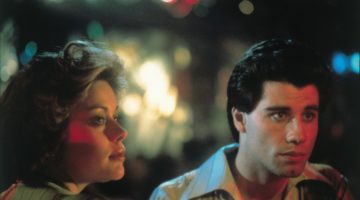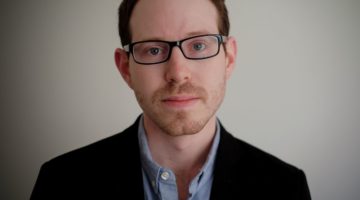Five Questions with Filmmaker Roberto Minervini
The latest retrospective from TIFF charts the career of Italian-born, Texas-based filmmaker Roberto Minervini. Often described as hybrid-documentaries, Minervini’s films enlist real people to play themselves in works that very much seem to follow a narrative structure. Showcasing his four films, the Minervini retrospective includes Stop the Pounding Heart, which premiered at Cannes in 2013, as well as his latest film The Other Side, which has its premiere at last year’s Toronto International Film Festival. Minervini will be onsite to introduce each of his films as well as to present his Carte Blanche selection of The Margin. We spoke we Minervini in before the retrospective about his process and evolution as a filmmaker.
Scene Creek: All your films are connected by the real people within them. The family from Stop the Pounding Heart was previously seen in The Passage, the bull rider from Low Tide was later seen in Stop the Pounding Heart, and one of the characters from your latest film The Other Side is related to one of the family members from Stop the Pounding Heart. Is this something you’re doing consciously?
Roberto Minervini: No actually. Not until my new film, which will be my fifth, am I consciously making the choice to work with some of the same people. Until then, for me the fact that I work with some of the same people stems from the fact that I approach cinema a little bit like life. Working where there is already an intimacy and trust established. The trust was already there, and I don’t think I would have been able to make the films I made or the way I made them if I didn’t know the actors before. The fact that they came back to my film is because in my films you see the role I live in everyday.
SC: The term “hybrid documentary” is frequently used when discussing your films. Would you describe them this way?
RM: No I wouldn’t. I’m not a documentary filmmaker; I’m not a fiction filmmaker. I wasn’t actually a filmmaker at all. I was a film lecturer. My intention has always been to have an academic career, which I had before these films. I was a professional in the Philippines. The fact that I work with real people in the confines of places and people I know, inevitably pushes me to look into their lives. They’re filmed inevitably as a testament to their lives. They have a documentary value. The form that I choose and the way i tell the story, which is mostly done during editing, gives the structure and the language that is more proper of fiction filmmaking. That is also because none of my collaborators are documentary filmmakers. Some of them, like the editor, have very successful careers in fiction filmmaking. So I guess it’s a combination of both. I think the fiction part of my film is myself; I stand between the material, the footage that I gather, and the editing in the final product. I am the filter. I am the one who chooses the language to tell the story, who chooses the style in the editing and adds a fictional aura to the films. Now the exception is The Passage, where I actually had written a screenplay that I abandoned as we progressed. I think it can be seen in the film that at some point I abandoned the script and that the people I encountered along the road just became part of the story. That film was more fictional than the others.
SC: So what changed for you between The Passage and Low Tide?
RM: It’s exactly the fact that The Passage was my first film and since I was completely alone with an ex-colleague from the Philippines and four former students. I’d written a screenplay because I was attempting to raise some funds, which I did thanks to something I wrote. I started working with this screenplay that I found to be too restraining and rigid. I completely lost interest in the filming process and I felt that I was missing opportunities of incorporating things that I encountered down the road. At some point I completely discarded it. I documented a lot of people coming along and they also improvised scenes. Perhaps in Cassavetes style where people improvise situations that stem from either past memories, like some of the moments of intimacy in the hotel. With Low Tide there was no screenplay, there was an outline, but I chose two family members to tell us their lives. With something like The Other Side there was absolutely nothing written down.
SC: It’s interesting how you talk about – I don’t want to use the terms “fiction” and “non-fiction” – but it almost seems as if for you something like The Other Side and Stop the Pounding Heart are more non-fictional than others. If we compare the aesthetic of Stop the Pounding Heart with the aesthetic of The Passage, it almost seems as if The Passage is presented as an observational documentary whereas Stop the Pounding Heart feels very cinematic.
RM: I think you’re absolutely right. That is due only I think to the inevitable awareness of the results. There’s an increased control of the medium and an awareness of the approach. Now we unfortunately in a way, and fortunately at the same time, we are more prepared. We know what to expect. We can control the outcome more and I think that it’s an inevitable consequence that I’ve made more films and become more experienced. The beautiful thing is that the photography reflects an aesthetic that I like. Perhaps the photographic beauty has evolved and it really reflects – well I think it’s beautiful in my previous films as well. The photography has become very controlled. Though, we never set up a shot or look for an angle on purpose. I never make requests for which angle to cover. Inevitably we instinctively just do it. We do it the proper filmic way. The sense of immediacy that we in a film like The Passage made us feel like punk rockers. Now we’re a little bit older, but we are still punk rockers in spirit. It’s really hard to be so free to mess it up completely like we did in The Passage. The camera moves very violently in that film. I wanted the camera to capture everything. The camera moves very abruptly from side to side to capture everything. It was an aesthetic choice. The fact that all of a sudden we made a film without enough preparation was a blessing in disguise. Now films are prepared, but I’m still a punk rocker.
SC: At TIFF’s retrospective your films are being shown in a reverse order of when they were made. Is that something that you’ve chosen or is that a programming decision.
RM: It’s a programming decision and it’s an interesting one. There’s been no discussion over that, but I would respect any decisions from the programmers. In other cases when there are retrospectives and when they ask for my input I ways ask for the films to be shown in order. It’s interesting for me to explain how I got to The Other Side from The Passage, but it’s also good to do that after the fact, after seeing my first film. To understand how it all started there, with me trying to control the film and knowing that the control was a limitation. In the end there’s more control over the form and language, less control over the content. Before it was just the other way around. As an evolution it’s good to see backwards.



